2009 Hyundai Santa Fe wheel
[x] Cancel search: wheelPage 149 of 269
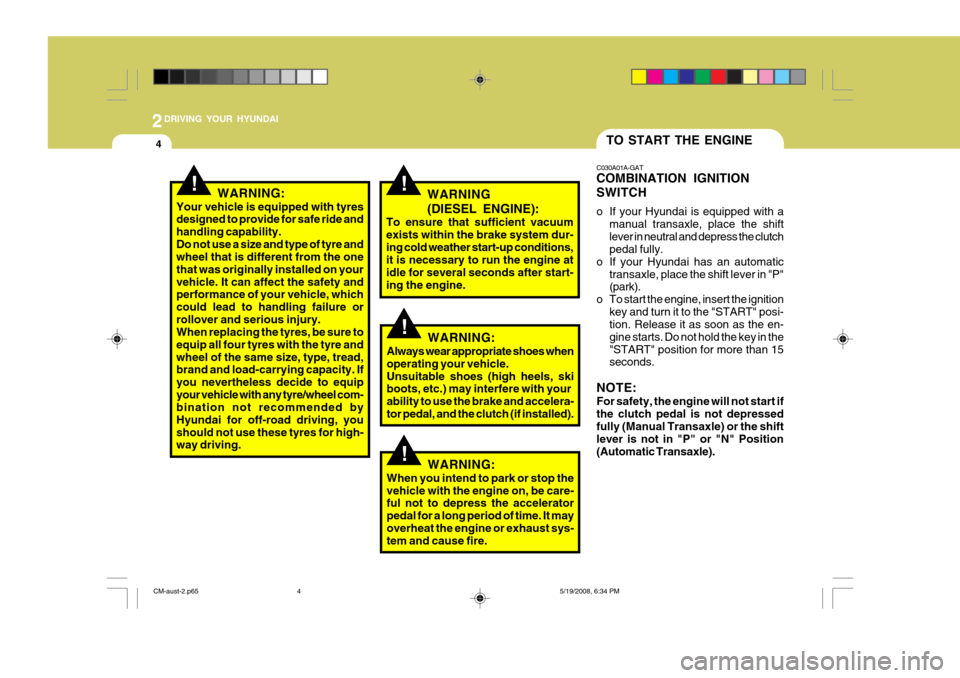
2DRIVING YOUR HYUNDAI
4
!
TO START THE ENGINE
C030A01A-GAT COMBINATION IGNITION SWITCH
o If your Hyundai is equipped with a manual transaxle, place the shift lever in neutral and depress the clutch pedal fully.
o If your Hyundai has an automatic
transaxle, place the shift lever in "P"(park).
o To start the engine, insert the ignition key and turn it to the "START" posi-tion. Release it as soon as the en- gine starts. Do not hold the key in the"START" position for more than 15 seconds.
NOTE: For safety, the engine will not start if the clutch pedal is not depressed
fully (Manual Transaxle) or the shift lever is not in "P" or "N" Position(Automatic Transaxle).
WARNING:
Your vehicle is equipped with tyres designed to provide for safe ride and handling capability.Do not use a size and type of tyre and wheel that is different from the one that was originally installed on yourvehicle. It can affect the safety and performance of your vehicle, which could lead to handling failure orrollover and serious injury. When replacing the tyres, be sure to equip all four tyres with the tyre andwheel of the same size, type, tread, brand and load-carrying capacity. If you nevertheless decide to equipyour vehicle with any tyre/wheel com- bination not recommended by Hyundai for off-road driving, youshould not use these tyres for high- way driving.
!WARNING:
Always wear appropriate shoes when operating your vehicle.Unsuitable shoes (high heels, ski boots, etc.) may interfere with your ability to use the brake and accelera-tor pedal, and the clutch (if installed).
!WARNING (DIESEL ENGINE):
To ensure that sufficient vacuum exists within the brake system dur-ing cold weather start-up conditions, it is necessary to run the engine at idle for several seconds after start-ing the engine.
!WARNING:
When you intend to park or stop the vehicle with the engine on, be care- ful not to depress the accelerator pedal for a long period of time. It mayoverheat the engine or exhaust sys- tem and cause fire.
CM-aust-2.p65 5/19/2008, 6:34 PM
4
Page 150 of 269

2
DRIVING YOUR HYUNDAI
5
!
KEY POSITIONS
o "ON" When the key is in the "ON" position, the ignition is on and all accessoriesmay be turned on. If the engine is not running, the key should not be left in the "ON" position. This will discharge thebattery and may also damage the igni- tion system.
o "ACC" With the key in the "ACC" position, the some electrical accessories (radio, etc.)may be operated.
o "LOCK" The key can be removed or inserted in this position. To protect against theft, the steering wheel locks by removing the key. NOTE: If difficulty is experienced in turning the ignition switch to the ACC posi-tion, turn the key while turning steer- ing wheel right and left to release the tension. C070C01A-AAT To Remove the Ignition Key
1. Turn the ignition key to the "ACC"
position.
2. Simultaneously push and turn the
ignition key counterclockwise from the "ACC" position to the "LOCK" position.
3. The key can be removed in the "LOCK" position.
C040A02A-AAT
WARNING:
The engine should not be turned offor the key removed from the ignitionkey cylinder while the vehicle is in motion. The steering wheel is locked by removing the key.
o "START" The engine is started in this position. It will crank until you release the key. NOTE: Do not hold the key in the "START" position for more than 15 seconds. C040A01E
LOCK
ACC
ON
START C070C01E
LOCK
ACC
ON
START
CM-aust-2.p65 5/19/2008, 6:34 PM
5
Page 154 of 269

2
DRIVING YOUR HYUNDAI
9
!
o Exercise extreme caution when driv-
ing on a slippery surface. Be espe- cially careful when braking, acceler- ating or shifting gears. On a slippery surface, an abrupt change in vehiclespeed can cause the drive wheels to lose traction and the vehicle to go out of control. WARNING:
o Avoid high cornering speeds.
o Do not make quick steering wheel movements, such as sharp lanechanges or fast, sharp turns.
o Always wear your seat belts.
In a collision crash, an unbelted person is significantly more likely to die than a person wearing aseat belt.
o The risk of rollover is greatly in- creased if you lose control of your vehicle at highway speeds.
o Loss of control often occurs if two or more wheels drop off theroadway and the driver oversteers to reenter the roadway.
o In the event your vehicle leaves
the roadway, do not steer sharply.Instead, slow down before pull- ing back into the travel lanes.
o Never exceed posted speed lim- its.
AUTOMATIC TRANSAXLE (4 SPEED A/T, 5 SPEED A/T)
C090A01NF-GAT (If installed)
The highly efficient Hyundai automatic transaxle has four/five forward speeds and one reverse speed. The individualspeeds are selected automatically, depending on the position of the speed selector lever. The selector lever has 2gates; the main gate and the manual gate. NOTE: For information on manual gate op- eration, refer to "Sports Mode". In the main gate, the selector lever has 4 positions.
OCM053004R
CM-aust-2.p65 5/19/2008, 6:34 PM
9
Page 158 of 269
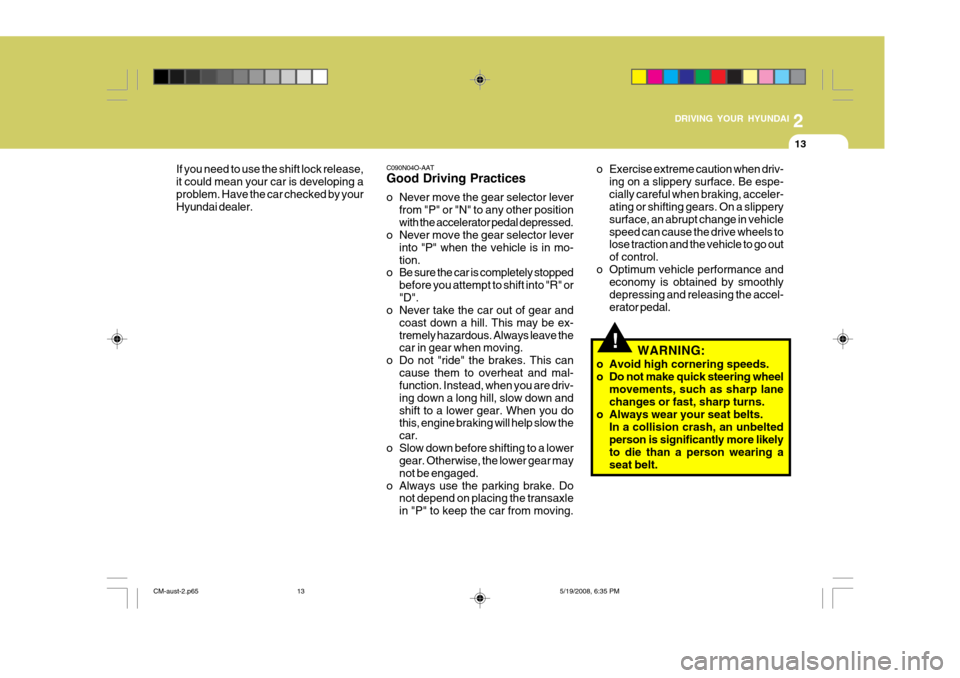
2
DRIVING YOUR HYUNDAI
13
!
C090N04O-AAT Good Driving Practices
o Never move the gear selector lever
from "P" or "N" to any other position with the accelerator pedal depressed.
o Never move the gear selector lever
into "P" when the vehicle is in mo-tion.
o Be sure the car is completely stopped
before you attempt to shift into "R" or"D".
o Never take the car out of gear and
coast down a hill. This may be ex-tremely hazardous. Always leave the car in gear when moving.
o Do not "ride" the brakes. This can cause them to overheat and mal-function. Instead, when you are driv- ing down a long hill, slow down andshift to a lower gear. When you do this, engine braking will help slow the car.
o Slow down before shifting to a lower gear. Otherwise, the lower gear maynot be engaged.
o Always use the parking brake. Do not depend on placing the transaxlein "P" to keep the car from moving.
If you need to use the shift lock release,it could mean your car is developing aproblem. Have the car checked by your Hyundai dealer.
o Exercise extreme caution when driv-
ing on a slippery surface. Be espe- cially careful when braking, acceler- ating or shifting gears. On a slippery surface, an abrupt change in vehiclespeed can cause the drive wheels to lose traction and the vehicle to go out of control.
o Optimum vehicle performance and economy is obtained by smoothlydepressing and releasing the accel-erator pedal.
WARNING:
o Avoid high cornering speeds.
o Do not make quick steering wheel movements, such as sharp lane changes or fast, sharp turns.
o Always wear your seat belts. In a collision crash, an unbelted person is significantly more likelyto die than a person wearing a seat belt.
CM-aust-2.p65 5/19/2008, 6:35 PM
13
Page 159 of 269
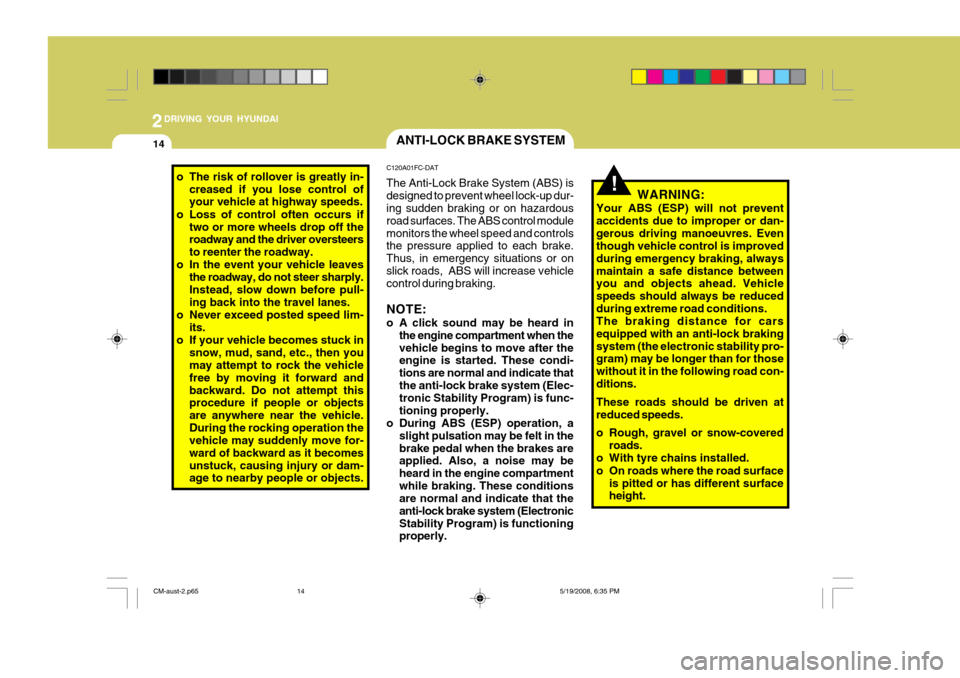
2DRIVING YOUR HYUNDAI
14
o The risk of rollover is greatly in-
creased if you lose control of your vehicle at highway speeds.
o Loss of control often occurs if two or more wheels drop off theroadway and the driver oversteers to reenter the roadway.
o In the event your vehicle leaves the roadway, do not steer sharply.Instead, slow down before pull- ing back into the travel lanes.
o Never exceed posted speed lim- its.
o If your vehicle becomes stuck in
snow, mud, sand, etc., then youmay attempt to rock the vehicle free by moving it forward andbackward. Do not attempt this procedure if people or objects are anywhere near the vehicle.During the rocking operation the vehicle may suddenly move for- ward of backward as it becomesunstuck, causing injury or dam- age to nearby people or objects.!WARNING:
Your ABS (ESP) will not prevent accidents due to improper or dan-gerous driving manoeuvres. Even though vehicle control is improved during emergency braking, alwaysmaintain a safe distance between you and objects ahead. Vehicle speeds should always be reducedduring extreme road conditions. The braking distance for cars equipped with an anti-lock brakingsystem (the electronic stability pro- gram) may be longer than for those without it in the following road con-ditions. These roads should be driven at reduced speeds.
o Rough, gravel or snow-covered roads.
o With tyre chains installed.
o On roads where the road surface is pitted or has different surface height.
ANTI-LOCK BRAKE SYSTEM
C120A01FC-DAT The Anti-Lock Brake System (ABS) is designed to prevent wheel lock-up dur- ing sudden braking or on hazardous road surfaces. The ABS control modulemonitors the wheel speed and controls the pressure applied to each brake. Thus, in emergency situations or onslick roads, ABS will increase vehicle control during braking. NOTE:
o A click sound may be heard in the engine compartment when the vehicle begins to move after the engine is started. These condi- tions are normal and indicate thatthe anti-lock brake system (Elec- tronic Stability Program) is func- tioning properly.
o During ABS (ESP) operation, a
slight pulsation may be felt in thebrake pedal when the brakes are applied. Also, a noise may be heard in the engine compartmentwhile braking. These conditions are normal and indicate that the anti-lock brake system (ElectronicStability Program) is functioning properly.
CM-aust-2.p65 5/19/2008, 6:35 PM
14
Page 160 of 269
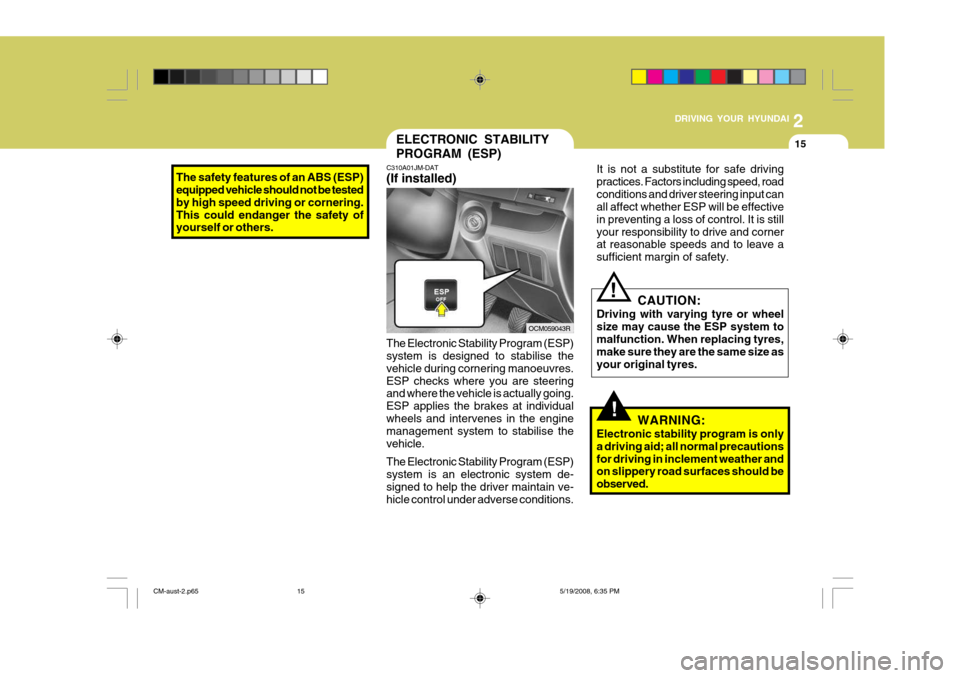
2
DRIVING YOUR HYUNDAI
15
The safety features of an ABS (ESP) equipped vehicle should not be tested by high speed driving or cornering.This could endanger the safety of yourself or others.
!
It is not a substitute for safe driving practices. Factors including speed, roadconditions and driver steering input can all affect whether ESP will be effective in preventing a loss of control. It is stillyour responsibility to drive and corner at reasonable speeds and to leave a sufficient margin of safety.
CAUTION:
Driving with varying tyre or wheelsize may cause the ESP system to malfunction. When replacing tyres, make sure they are the same size asyour original tyres.
WARNING:
Electronic stability program is onlya driving aid; all normal precautionsfor driving in inclement weather and on slippery road surfaces should be observed.
!
ELECTRONIC STABILITY PROGRAM (ESP)
C310A01JM-DAT (If installed) The Electronic Stability Program (ESP) system is designed to stabilise the vehicle during cornering manoeuvres.ESP checks where you are steering and where the vehicle is actually going. ESP applies the brakes at individualwheels and intervenes in the engine management system to stabilise the vehicle. The Electronic Stability Program (ESP) system is an electronic system de-signed to help the driver maintain ve- hicle control under adverse conditions. OCM059043R
CM-aust-2.p65
5/19/2008, 6:35 PM
15
Page 161 of 269

2DRIVING YOUR HYUNDAI
16FULL-TIME 4WD OPERATION
C350A03O-DAT Engine power can be delivered to all front and rear wheels for maximum power. Full-time 4WD is useful when good traction is required, such as, whendriving on slippery, wet or snow-cov- ered roads and when moving out of mud. Driving 4WD Safely
(1)Be sure to wear the seat belt.
(2)Drive at lower speeds in strong cross- winds. Because of your vehicle's high centre of gravity, its stability will be affected in crosswinds. Slowerspeeds ensure better vehicle con- trol.
(3)Check the brake condition after driv- ing in wet or muddy conditions. Pressthe brake several times as you move slowly until you feel normal brakingforces return.
(4)Do not drive the vehicle through wa-
ter. (i.e. streams, rivers, lakes, etc.)
C310B01JM-AAT ESP ON/OFF Mode When the ESP is operating, the ESP indicator in the instrument cluster willblink. If you turn the system off by pressing the ESP switch, the ESP-OFF indica-tor will come on and stay on. In the ESP-OFF mode, the stability control will be deactivated. Adjust your drivingaccordingly. To turn the system back on, press the switch again. The ESP- OFF indicator should go off. NOTE: The ESP mode will automatically be turned ON after the engine is turnedoff and restarted.
C310D01JM-DAT Indicators and Warning The indicators should illuminate when the ignition key is turned to ON orSTART but should go out after three seconds. If the indicators do not illuminate, or theESP or ESP-OFF indicator does not go out after 3 seconds, have the vehicle checked by an authorised dealer. Should there be any unusual conditions in the device while driving, ESP-OFFindicator illuminates as a warning. If ESP-OFF indicator illuminates, pull your car to a safe place and stop theengine. Then, start the engine again to check if the ESP-OFF indicator goes out. If the indicator remains lit even after the engine has been started, have your carchecked by an authorised Hyundai dealer.
CM-aust-2.p65
5/19/2008, 6:35 PM
16
Page 162 of 269
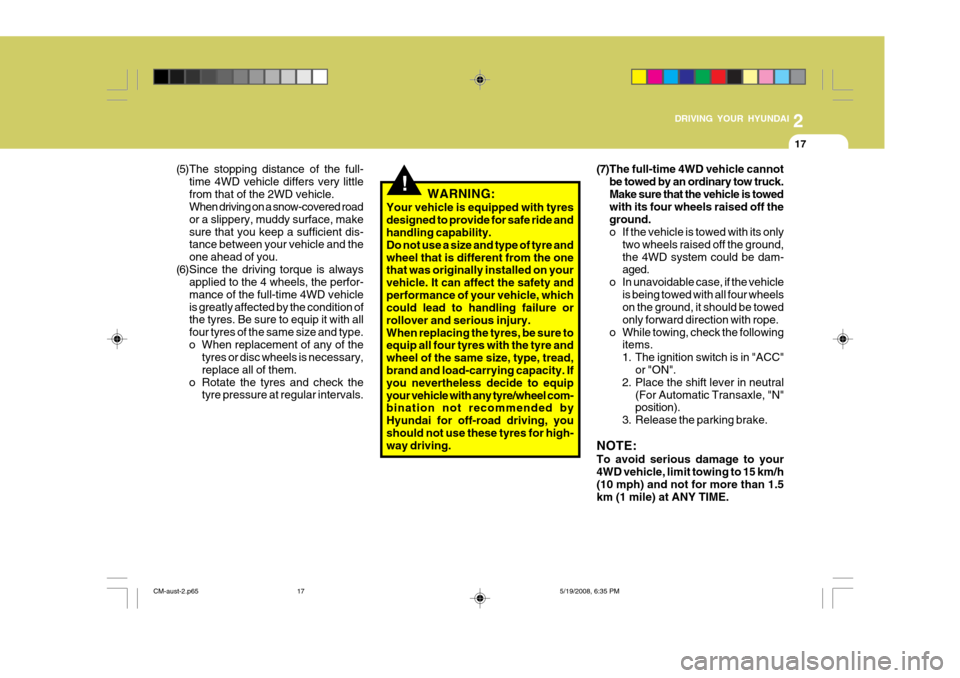
2
DRIVING YOUR HYUNDAI
17
!
(7)The full-time 4WD vehicle cannot
be towed by an ordinary tow truck. Make sure that the vehicle is towed with its four wheels raised off the ground.
o If the vehicle is towed with its only two wheels raised off the ground,the 4WD system could be dam- aged.
o In unavoidable case, if the vehicle
is being towed with all four wheelson the ground, it should be towed only forward direction with rope.
o While towing, check the following items.
1. The ignition switch is in "ACC" or "ON".
2. Place the shift lever in neutral
(For Automatic Transaxle, "N" position).
3. Release the parking brake.
NOTE: To avoid serious damage to your 4WD vehicle, limit towing to 15 km/h (10 mph) and not for more than 1.5km (1 mile) at ANY TIME.
(5)The stopping distance of the full-
time 4WD vehicle differs very littlefrom that of the 2WD vehicle. When driving on a snow-covered road or a slippery, muddy surface, makesure that you keep a sufficient dis- tance between your vehicle and the one ahead of you.
(6)Since the driving torque is always applied to the 4 wheels, the perfor-mance of the full-time 4WD vehicleis greatly affected by the condition of the tyres. Be sure to equip it with all four tyres of the same size and type.
o When replacement of any of the tyres or disc wheels is necessary,replace all of them.
o Rotate the tyres and check the tyre pressure at regular intervals. WARNING:
Your vehicle is equipped with tyresdesigned to provide for safe ride and handling capability. Do not use a size and type of tyre andwheel that is different from the one that was originally installed on your vehicle. It can affect the safety andperformance of your vehicle, which could lead to handling failure or rollover and serious injury.When replacing the tyres, be sure to equip all four tyres with the tyre and wheel of the same size, type, tread,brand and load-carrying capacity. If you nevertheless decide to equip your vehicle with any tyre/wheel com-bination not recommended by Hyundai for off-road driving, you should not use these tyres for high-way driving.
CM-aust-2.p65 5/19/2008, 6:35 PM
17